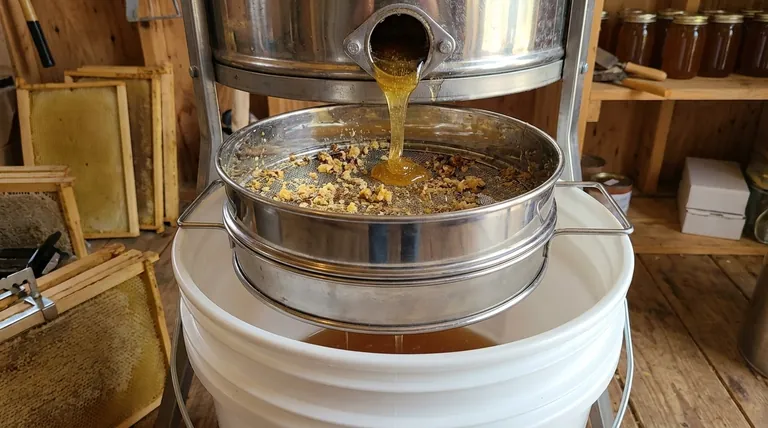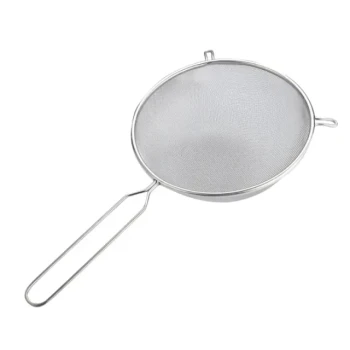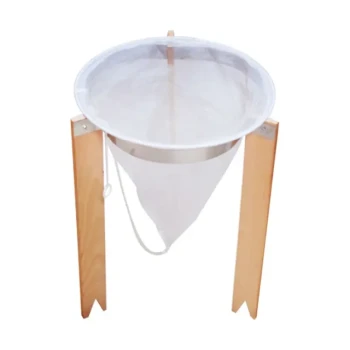For sieving raw honey, the essential tool is a honey sieve or strainer, which is typically made of metal mesh. Its specific purpose is to filter out large physical impurities, such as pieces of beeswax, propolis, and bee parts, that are present in the honey after it leaves the extractor. This initial straining step is crucial for preparing clean, high-quality honey for bottling and consumption.
Choosing the right sieve is a critical control point in honey production. It's a balance between achieving the desired clarity and preserving the honey's natural components, with the sieve's mesh size being the most important factor in that decision.

The Role of a Honey Sieve in Production
Why Sieving is Necessary
Raw honey, fresh from the extractor, contains various forms of debris from the hive. This includes wax cappings, propolis, and sometimes even bee parts.
Sieving is the process of removing these unwanted solids to produce a clean, clear final product that is appealing and ready for the jar.
The Primary Tool: The Honey Sieve
A honey sieve is a purpose-built strainer designed for viscous liquids. Most are made from food-grade stainless steel for durability and ease of cleaning.
They are often designed with extendable arms or a tapered shape to sit securely on top of a standard 5-gallon bottling bucket.
The Double-Sieve System
Many honey sieves feature a two-stage design to improve efficiency.
A coarse top sieve catches the largest pieces of wax and debris, while a finer bottom sieve catches smaller particles. This prevents the finer mesh from clogging too quickly, allowing for a faster, more continuous workflow.
Understanding the Trade-offs
Clarity vs. Natural Components
The fineness of the mesh directly impacts the final product. A very fine mesh will produce exceptionally clear honey but may also filter out some beneficial pollen grains.
Conversely, a coarser mesh will leave more pollen and fine wax particles in the honey, resulting in a more "raw" or rustic character that many consumers value.
Temperature and Flow Rate
Honey is highly viscous, meaning it flows slowly. This is especially true at cooler temperatures.
Straining cold honey can be a very slow process and can cause the sieve to clog easily. Gently warming the honey (to no more than 95°F or 35°C) will lower its viscosity, allowing it to flow through the sieve much more easily.
Material Matters
While other materials exist, stainless steel is the industry standard for a reason. It is non-reactive, so it won't impart any flavor to the honey.
It is also extremely durable and easy to sanitize, which is critical for ensuring the quality and safety of your honey.
Making the Right Choice for Your Goal
Selecting the correct sieving method depends entirely on the kind of honey you aim to produce.
- If your primary focus is producing rustic, raw honey: Use a single, coarse sieve just to remove the largest debris like bee parts and chunks of wax.
- If your primary focus is bottling clear honey for sale: A standard stainless steel double-sieve (coarse over fine) is the most efficient and effective tool.
- If your primary focus is operational efficiency: Ensure your honey is slightly warmed before straining to significantly speed up the process and prevent clogs.
Ultimately, using the right sieve is a fundamental step that allows you to control the quality and character of your final product.
Summary Table:
| Sieve Type | Primary Use | Key Feature |
|---|---|---|
| Coarse Sieve | Removing large debris (wax, bee parts) | Ideal for rustic, raw honey |
| Double-Sieve (Coarse & Fine) | Bottling clear honey for sale | Improves efficiency, prevents clogs |
Ready to optimize your honey production with the right equipment?
HONESTBEE supplies durable, food-grade stainless steel honey sieves and other essential beekeeping supplies to commercial apiaries and distributors. We understand the critical balance between clarity and efficiency in your operation. Our wholesale-focused operations ensure you get the reliable equipment you need to produce high-quality honey.
Contact our team today to discuss your sieving needs and explore our product range.
Visual Guide

Related Products
- Professional Stainless Steel Honey Filter with Support Handle
- Professional Honey Filter with Tripod Support Stand
- Nylon Honey Strainer Square Filter Cloth for Honey Filters
- Professional Cone-Shaped Honey Filter with Reinforced Steel Ring
- Two-Stage Plastic Honey Filter for Buckets
People Also Ask
- How do I choose a mesh size for a strainer? Balance Protection and Performance
- Why might honey need to be heated before filtering? To Reduce Viscosity for Clearer, Marketable Honey
- What is the process of filtration in honey processing? A Guide to Purity & Shelf Life
- Is it necessary to filter honey after extraction? A Guide to Straining vs. Raw Honey
- What Micron is best for filtering honey? Choose the Right Filter for Show-Quality or General Sales



















